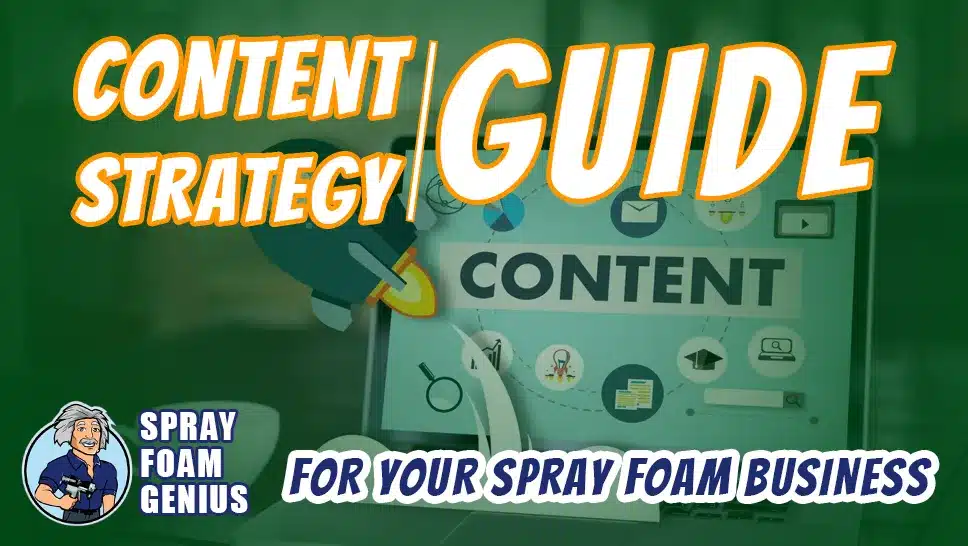
Spray foam insulation contractors face a unique set of challenges in the competitive world of home improvement and construction. With more homeowners and businesses seeking energy-efficient solutions, spray foam insulation has become a sought-after service. However, standing out in this crowded market requires more than just exceptional workmanship; it demands a well-crafted content strategy tailored to your business’s needs. At Spray Foam Genius Marketing, we understand the intricacies of this niche market, and in this post, we’ll guide you through creating a content strategy that drives traffic, generates leads, and establishes your authority in the industry.
Why a Content Strategy Matters for Your Spray Foam Business

Before diving into the how-tos, it’s crucial to understand why a content strategy is vital for your spray foam business. Content marketing is no longer optional; it’s a necessity. A strategic approach to content can help you:
- Increase Visibility: With the right content, your business can rank higher on Google, making it easier for potential customers to find you.
- Establish Authority: By consistently providing valuable and informative content, you position your business as an expert in the spray foam industry.
- Generate Leads: Quality content can drive potential customers to take action, whether it’s filling out a contact form, calling your business, or requesting a quote.
- Build Trust: Trust is paramount in the home improvement industry. Sharing your expertise through content builds credibility with your audience.
Step 1: Understand Your Audience
The first step in creating a content strategy for your spray foam business is understanding your target audience. Who are they? What problems do they face? What are their needs and preferences?
For spray foam insulation contractors, the primary audience is typically homeowners, property managers, and commercial building owners looking for energy-efficient insulation solutions. However, it’s important to dig deeper:
- Demographics: Consider the age, income level, and geographic location of your target audience. Are they in urban or rural areas? What is their budget range?
- Pain Points: What problems are they trying to solve? Are they dealing with high energy bills, draft homes, or outdated insulation?
- Buying Behavior: How do they make purchasing decisions? Do they rely on online reviews, referrals, or in-depth research?
Step 2: Conduct Keyword Research
Once you’ve identified your audience, the next step is conducting keyword research. Keywords are the phrases and terms your potential customers use when searching for services like yours online.
For instance, potential keywords for spray foam businesses could include:
- Primary Keywords: “spray foam insulation,” “insulation contractors,” and “energy-efficient insulation.”
- Secondary Keywords: “home insulation services,” “attic insulation,” and “commercial insulation solutions.”
- LSI Keywords: “reduce energy bills,” “eco-friendly insulation,” “home improvement.”
Use tools like Google Keyword Planner, Ahrefs, or SEMrush to find relevant keywords with high search volume and low competition. Focus on long-tail keywords, as they often reflect more specific search intents and are easier to rank for.
Step 3: Create a Content Calendar
A content calendar is your roadmap for content creation. It helps you plan and organize your content efforts over a specific period, ensuring consistency and alignment with your business goals.
- Frequency: Decide how often you’ll publish content. This could be weekly, bi-weekly, or monthly, depending on your resources and audience needs.
- Content Types: Diversify your content types to keep your audience engaged. Consider blog posts, how-to guides, case studies, infographics, and videos.
- Topics: Choose topics that resonate with your audience and align with your keywords. For example, a blog post titled “5 Benefits of Spray Foam Insulation for Homeowners” targets both homeowners and the keyword “spray foam insulation.”
Step 4: Develop High-Quality Content
Creating high-quality content is at the heart of your strategy. It’s not enough to produce content for the sake of it; your content must be valuable, informative, and engaging. Here’s how to ensure your content hits the mark:
- Provide Value: Address common questions and problems your audience faces. For example, “How Spray Foam Insulation Can Save You Money on Energy Bills” provides practical insights that appeal to cost-conscious homeowners.
- Showcase Expertise: Use your industry knowledge to create authoritative content. Consider writing detailed guides on the benefits of spray foam insulation, the installation process, or how to choose the right contractor.
- Optimize for SEO: Incorporate your keywords naturally within the content. Include headings, meta descriptions, and alt texts that enhance SEO without compromising readability.
- Visual Appeal: Use relevant images, infographics, and videos to break up text and make your content more visually appealing. For instance, a video showing a spray foam insulation process can be more engaging than a lengthy text explanation.
Step 5: Promote Your Content
Creating content is only half the battle; promoting it is equally important. Here are some effective ways to get your content in front of your target audience:
- Social Media: Share your content on platforms where your audience is active, such as Facebook, LinkedIn, and industry-specific forums. Use compelling headlines and visuals to draw attention.
- Email Marketing: Send your content directly to your subscribers through email newsletters. For example, a monthly newsletter featuring your latest blog posts and industry news can keep your audience informed and engaged.
- Guest Posting: Contribute articles to industry-related blogs and websites. This not only helps you reach a broader audience but also builds backlinks to improve your SEO.
- Google My Business: Regularly update your Google My Business profile with new content. Posts about recent projects, customer testimonials, and educational blog articles can enhance your local SEO efforts.
Step 6: Monitor and Adjust Your Strategy
A content strategy is not static; it requires regular monitoring and adjustments based on performance. Use tools like Google Analytics to track metrics such as:
- Traffic: Monitor the number of visitors to your site and identify which content is driving the most traffic.
- Engagement: Analyze how long visitors stay on your site, which pages they visit, and their bounce rate.
- Conversions: Track how many visitors take action after consuming your content, whether it’s filling out a contact form, calling your business, or requesting a quote.
Based on these insights, adjust your content strategy to improve performance. For example, if a blog post on “The Advantages of Spray Foam Insulation” is generating high traffic but low conversions, you may need to tweak the call-to-action or offer more compelling incentives.
Step 7: Leverage User-Generated Content and Reviews
User-generated content (UGC) and reviews are powerful tools for building trust and credibility. Encourage satisfied customers to share their experiences with your services through testimonials, social media posts, and online reviews.
- Testimonials: Feature customer testimonials on your website and in your content. Authentic reviews can influence potential customers’ decisions.
- Case Studies: Create detailed case studies highlighting successful projects. Include before-and-after photos, project details, and customer feedback to showcase your expertise.
- Online Reviews: Actively manage and respond to online reviews on platforms like Google My Business, Yelp, and Angi. Positive reviews can boost your reputation while responding to negative reviews demonstrates your commitment to customer satisfaction.
Step 8: Include a Strong Call-to-Action (CTA)
Every piece of content should include a clear and compelling call to action (CTA). Your CTA should guide the reader toward the next step in the customer journey, whether it’s contacting you for a quote, subscribing to your newsletter, or learning more about your services.
Elevate Your Spray Foam Business with a Strategic Content Plan
Creating a content strategy for your spray foam business is not just about increasing traffic or ranking higher on Google; it’s about providing value to your audience, establishing your authority, and building long-lasting customer relationships. By understanding your audience, producing high-quality content, and promoting it effectively, you can set your business apart from the competition and drive sustainable growth.
Remember, at Spray Foam Genius Marketing, we’re here to help you every step of the way. Whether you need assistance with SEO, Google My Business optimization, or developing a comprehensive content strategy, our expert team has the experience and expertise to help your spray foam business thrive. Call us at 877-840-FOAM for USA and 844-741-FOAM for Canada visit our website at sprayfoamgeniusmarketing.com, or email us at [email protected] to get started.
- Social Media Marketing for Spray Foam Businesses: What Works in 2025? - February 6, 2025
- Best SEO Strategies for Spray Foam Insulation Contractors to Rank #1 on Google - February 6, 2025
- What is Spray Foam Insulation? Benefits and Applications - February 5, 2025

